Mon 3 May 2010
Another Science Experiment
Posted by anaglyph under DIY, Gadgets, Hokum, Science, Skeptical Thinking, WooWoo
[80] Comments
I really love science. No matter how much stuff there is to know, there is always some more to find out, and as we saw in my recent science experiment, even the simplest of ideas can be full of rich and surprising consequences. Today I hope you will join me as we venture into the world of magnetism, electricity and digital information.
Part 1
For this part of the experiment we will need:
•A small amount of fine iron powder or iron oxide
•A magnet
•An old credit card or similar swipe card
•A magnifying glass
You can get some iron powder by filing down an old key (an iron or steel one – brass or aluminium won’t work), or even easier, by finding some iron oxide – commonly known as rust – and scraping it into a small container. You don’t need too much, but it should be as fine as you can make it.
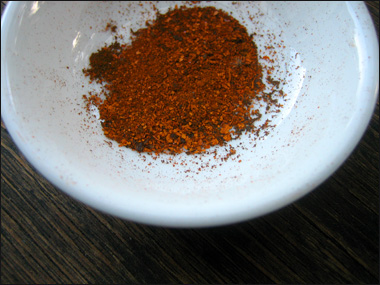
Now, I don’t think you will find it at all surprising that iron oxide is magnetic. If you take a magnet like this:

And hold it near the iron oxide, you will quite quickly see that the magnet attracts it:
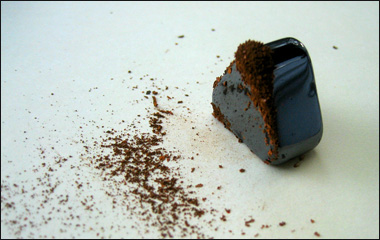
The strip on a credit card is also magnetized. Here is one I’ve acquired for our experiment.
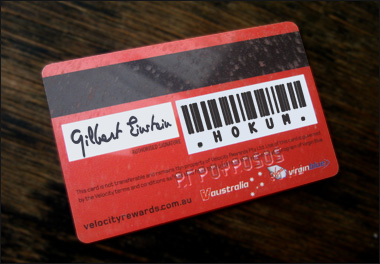
I don’t think Gilbert will mind us using his Virgin Frequent Flyer card (he doesn’t travel much anymore, after a clairvoyant told him he was going to die horribly in a plane crash). Gilbert’s card is fairly worn from carrying it around in his wallet, but we should not worry too much. The magnetic strip on a credit card is very robust and has been designed to cope with repeated handling. Although it is possible for the strip to be damaged by a very strong magnetic field, or through many years of wear and tear, the information recorded on it has a usefully long lifespan under most conditions, as I’m sure any of you with credit cards will know.
The strip on Gilbert’s card is actually really just a magnetic field that is recorded in various strengths to reflect a coding system for digital data. It is, in fact, just a magnetic field version of the common barcode with which I am sure you are familiar. The barcode records its data as a series of light and dark stripes, and the information of a swipe card is recorded in pretty much the same way, only with bands of varying magnetism. It follows then, that if we were to sprinkle something made of very fine metal powder, such as our iron oxide, onto the magnetic strip on Gilbert’s card, we would be able to see the particles sticking to the more magnetic parts of the strip.
Let’s try it!
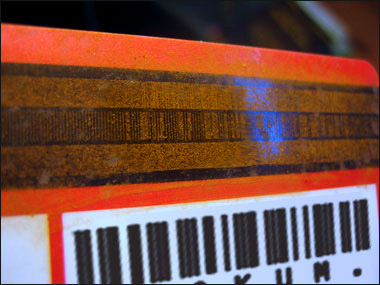
Let’s have a closer look at that with the magnifying glass!
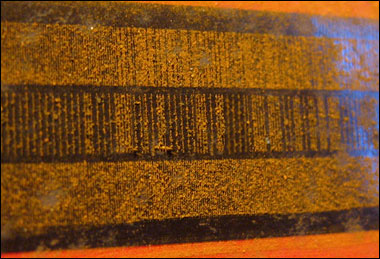
Amazing! The fine particles clearly delineate the data on the card! What we’re seeing here tells us lots about how a credit card works. First of all, you will notice that Gilbert’s card has three horizontal magnetic bands. This is the standard for all swipe cards. In most cases, information is recorded on one, or sometimes two of these bands. The two outside bands are called high density tracks and contain data at 210 bits per inch. If you know anything about computers, you will realise that the term ‘high density’ here is relative: 210 bits per inch, by modern data standards, is pretty damn lousy. To give you some idea, one of these tracks can carry about 79 x 6bit alphanumeric characters. Your credit card would typically have, on track 1, your name, your card number and an expiry date. That’s it. Not much.
The middle strip is called the low density track and is able to carry only 40 x 4bit characters. Often, the data is similar to what is on the first track, typically a repeat of the card or account number, and the expiry date. The third track is recorded at a lower bit rate than track #1 so can carry 107 characters at 4bits each.
The important thing to note here is that a magnetic strip can carry, on all of the three stripes combined, a total of roughly 1000 bits of data. ((1062bits, if you do the sums)) You may be more familiar with that as 1k. That data is encoded to be read as alphanumeric characters, and we’re talking about, at maximum capacity, 226 letters, numbers and punctuation symbols.
That’s about the same amount of information you can send in one single SMS ((SMS messages are encoded in 7bit characters: 160 x 7bits = 1120bits))
Part 2
For this part of the experiment we will need:
•Iron oxide powder (as above)
•A Shoo!Tag™ card
(You’re really glad you stuck with me, now, aren’t you?)
Shoo!Tag™ cards are available from some pet supply places. ((Just an aside here – when I purchased my ShooTags I asked the sales assistant whether they sold many. ‘Nah’, she said ‘They’re rubbish.’)) They are small plastic credit-card style tags that the makers claim use ‘a three dimensional or trivector signature imprinted onto the magnetic field of a three field magnetic memory card to create a protective barrier from pests.’ The Shoo!Tag™ ((I’m fairly certain that they don’t actually have a trademark for Shoo!Tag, but we shall see how that pans out)) vendors don’t explain anywhere how this amazing feat is accomplished.
Here’s one I acquired earlier. It’s supposed to be for keeping ticks off cats:
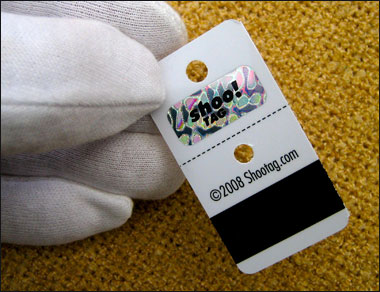
You’ll notice I’m handling it very carefully. I don’t want to damage any of the fragile ‘electro-hoodjy-goodjy vibes’ that the maker insists accompany this card. This is the packaging in which the Shoo!Tag arrived:
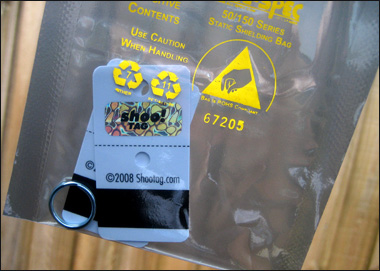
It’s a mylar anti-static bag, which, as you probably know, is designed to protect sensitive electrical components from static charges.
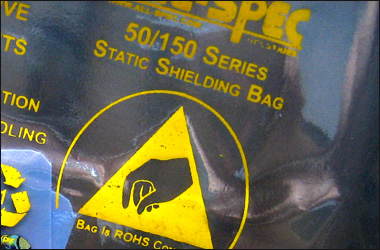
Now, static electricity has next to no effect on magnets. ((Unless we’re talking about lightning, which is a kind of static electricity. But no mylar bag is going to protect your ShooTag if it gets struck by lightning, I can assure you.)) And, as far as I can tell, there are no electrical components of any kind in the ShooTag card. ((Unless they are very very thin – alien technology, maybe? Well, that’s at least as plausible as the cards having any effect!)) What, then, is the purpose of this mylar bag? Has your American Express card ever arrived in the mail in a mylar bag? Does your bank advise you to keep your credit card in a mylar bag when not in use? They do not. Furthermore, you can build up a very decent static charge by scuffing your shoes on the carpet of your lounge room – enough to cause sparks to jump from you hand to a doorknob – but it will not effect the information on any of the credit cards in your wallet.
Ever.
But perhaps the magnetic strip of a ShooTag isn’t actually magnetic! Maybe it’s some other clever kind of technology that IS affected by static electricity. Surely it couldn’t be plain ol’ garden variety … magnetic data…
I can tell you’re ahead of me. Have you got your iron oxide powder at the ready?
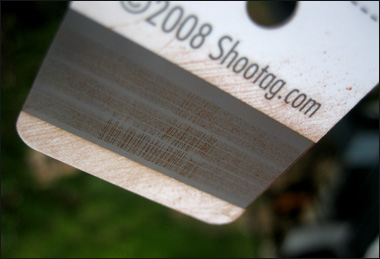
Well look at that. The magnetic strip on a ShooTag is just what you’d expect to find on a standard swipe card – three tracks encoding some data. Just like any ol’ credit card. Or a barcode. Let’s take a closer look at the actual data area of the code:
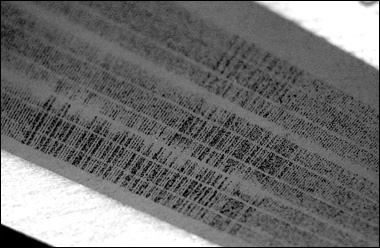
You can clearly see the actual encoded data – it forms the little segments that stand out in the middle of each of the three tracks. The uniform areas on either side, where there is no variation, are the ‘zero’ bits – null areas where the digital information message says ‘there is nothing here’.
I’ll outline it a little more clearly for you:
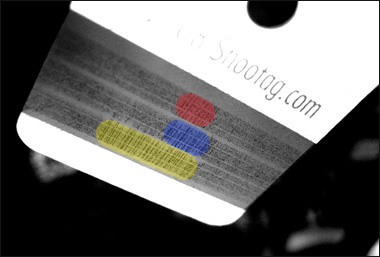
By my estimation, the actual area of the the magnetic strip that’s actually encoded with data is about a third of the total area. ((I’m being generous – it’s probably even less)) And, as you can see if you go up to the first ShooTag picture above, this card – the one for cats – is about one third the size of a standard credit card. So the information encoded on a ShooTag for cats is one third of one third of the amount of information on a standard credit card.
That’s one third of one third of the information you can send in an SMS. Roughly 17 characters.
This much:
FLEAS! PISS OFF!! ((The spaces count as characters))
Even if you assume that the digital information is not in the form of words or numerals, the total amount of data is only around 102bits. This, supposedly, is the sum total of the data used by ShooTag’s ‘physics, quantum physics and advanced computer software technology’ ((Verbatim from their ‘Science’ page)) to create the three dimensional electromagnetic field that gives it the awesome power to repel insects. Not only that, but the data also targets different insects according to which kind of card you have. Of course, this may all be explained by ‘the advanced computer software technology’ that the ShooTag creators claim they use, but in that case they are seriously in the wrong business; with data compression routines that impressive, they are trifling with a few dollars made of the back of plastic cards – they could be earning billions in Silicon Valley!
Let’s pause for a second and try and understand what kind of mechanics are supposed to be going on with these things. There is a reason, and only one reason, that information is encoded onto a magnetic strip on a plastic card. It’s a basic, practical and easy-to-understand reason: it’s so that you can swipe it through a card reader. Otherwise – seriously – WHAT IS THE POINT of recording magnetic information in this fashion? What the ShooTag people are asking us to believe is that some kind of magic happens when information is transferred onto a ShooTag magnetic strip that allows it to be scanned by… what?… the Universe? Fleas with miniature EFTPOS machines? God?
On their site the ShooTaggers say that there are ‘frequencies’ embedded in the magnetic strip ((because we can see the data, we have to assume they mean ‘recorded on’ rather than ’embedded in’)) which, using ‘earth energies similar to Schumann Waves’ (a piece of idiocy that we have discussed previously), somehow communicates with the supposed ‘bio-energetic field which surrounds all living things’. ((This is also silly doublespeak undoubtedly inherited from the misunderstandings surrounding Kirlian photography and other similar ‘proofs’ of ‘bio-energy’)) What possible mechanism could allow that? There is nothing known to science that says that a few trivial bits of magnetic data could meaningfully influence anything other a purpose-built magnetic card scanner (or some iron oxide particles, I guess). It’s nonsense of a truly breathtaking magnitude.
You will recall that I mentioned that I received 2 cards in my ShooTag package. The one we’ve been examining above is supposedly designed to repel ticks. Well, we don’t have much of a tick problem here, so I have been able to sacrifice any spooky vibes it may have had to our science experiment. The other ShooTag in my package is for the dispersal of fleas. I have been extremely careful with the other card. It has remained in its packaging and, as you saw, I have used cotton gloves whenever handling the mylar package containing the tags.
That’s because this experiment has a Part 3, and, with a certain feline helper, we are going to run our own field trial with the ShooTag. And I can assure you I will be undertaking this part of the experiment with as much rigour as any of the people who have submitted glowing testimonials on the ShooTag site.
Stay with me, won’t you?
80 Responses to “ Another Science Experiment ”
Trackbacks & Pingbacks:
-
Use rust particles to reveal the data on your credit-card’s magstripe…
Here’s a fun science experiment: finely powder some rust and then blow it over the magstripe on your credit card and you can see the zeroes and ones encoded on it by the stripes where the magnetic forces attract the ferrous particles. For a bonus, Ana…
-
[…] This post was mentioned on Twitter by Warren Guy and Roger Yerramsetti, Sandijs Jercums. Sandijs Jercums said: KÄ padarÄ«t redzamus datus uz kredÄ«tkartes magnÄ“tiskÄ celiņa: https://www.tetherdcow.com/?p=7497 […]
-
[…] No wonder the Japanese have been swiping their phones at vending machines all these years. [Tethered Cow via Boing […]
-
[…] Another Science Experiment […]
-
[…] No wonder the Japanese have been swiping their phones at vending machines all these years. [Tethered Cow via Boing Boing] Tagged:experimentsmagnetismmagnetsrandom stuffwhat is […]
-
[…] cool trick from anaglyph: Apply powdered iron oxide to the magnetic stripe on a swipe card to visualize the encoded data. […]
-
[…] How to do it at Tethered Cow Ahead: •A small amount of fine iron powder or iron oxide •A magnet •An old credit card or similar swipe card •A magnifying glass […]
-
[…] después de “restregarla” por cientos de lectores es lo normal.— ani Burón [Tethered Cow]Leer más aquÃ: Foto inquietantePor: GIZMODO @Gizmodo_ESSecciones: Gadgets Tags: banda magnética […]
-
[…] cool trick from anaglyph: Apply powdered iron oxide to the magnetic stripe on a swipe card to visualize the encoded data. […]
-
[…] cool trick from anaglyph: Apply powdered iron oxide to the magnetic stripe on a swipe card to visualize the encoded data. […]
-
[…] Asiasta tarkemmin kiinostuneille voi suositellla Tethered Cow-blogin ansiokasta selvitystä. […]
-
[…] Tethered-cow blogi otti selvää, minkälainen energia-allekirjoitus Shoo!Tagin magneettiraitaan sisältyy. Kävi […]
-
[…] Tetherd Cow Ahead posts an interesting science experiment. All you really need is a little bit of iron powder and a magnet, and you can unveil the info behind the magstripe on a credit card. […]
-
[…] Tetherd cow ahead […]
-
[…] Quelle: Another Science Experiment « Tetherd Cow Ahead […]
-
[…] Another Science Experiment « Tetherd Cow Aheadhttps://www.tetherdcow.com/another-science-experiment/ […]
-
[…] That’s about the same amount of information you can send in one single SMS(ii) […]

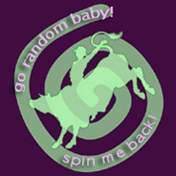


ShooTag isn’t trademarked because they’re full of ©®ap.
So Shoo Tag is a secret progect by the goverment then
Yes, that’s right Malach (what the fuck is he on?)
Here you are again, running your smarâ„¢outh about the awesome ShooTag.
Thanks ‘Wombat’. Ya wombat.
LOL Wombat, err I mean Atlas!
Tell us Wombat, how have you used the awesome Shoo, as a suppository?
The King
You can use ShooTag as a suppository, but I wouldn’t recommend it. With those folks, the shit just keeps coming and coming.
“Now now. We’re conducting a science experiment here.”
See. It does get in.
Queen Willy – I’ve taken the liberty of updating your comment with an appropriate link so that non-antipodeans can experience the true wonder of Mrs Marsh’s wisdom.
If you have a barcode reader, maybe you can decipher what the shoo tag actually says…
Hello pb, welcome to The Cow! Sadly, I don’t think a barcode reader uses the same coding method. I actually do have a barcode reader, but it’s no joy on any of the above.
I wonder if you could hack these? What would happen if you overwrote the content of the strip somehow, with some other data? Could you repel other things, like irritating inlaws, bill collectors, or crazy drivers?
What if you could make them repel people who believe in pseudoscientific nonsense? What would happen when they try to wear it? Alas, probably not enough data storage space for that.
I like the process (simple and cheap). We actually played with some cool magnetic viewing paper which is similar to your technique.
http://hackedgadgets.com/2007/05/10/magnetic-viewing-paper/
Wow, that’s also cool. Have you tried it on credit cards?
I like the idea (of visualizing the mag-strip data) :)
You don’t need a card reader, just read it off the card, using your photo!
Let’s see, it’s either 6 bits + 1 for parity, or 4+1, both odd parity (which means every cluster of 5 or 7 bits will have an odd number of 1s in).
Pattern on the bottom row (which I’ll call row 3, though it might be row 1 technically) looks like:
101000101001010000100110010001001010000100110010011001000110010001101010100101000011111111110110000
I’m not sure I’m reading them right. Maybe I’m not. But coincidentally, this set of bits can be split up into groups of 7 with odd parity in exactly one way, and groups of 7 with even parity in no ways, and groups of 5 with either parity in no ways. That sounds too good for coincidence.
1010001 0100101 0000100 1100100 0100101 0000100 1100100 1100100 0110010 0011010 1010010 1000011 1111111 1011000
Stripping out the parity bit and mapping to DEC SIXBIT:
Forwards, ignore first bit:
010001(1) 100101(E) 000100(FF) 100100(D) 100101(E) 000100(FF) 100100(D) 100100(D) 110010(R) 011010(:) 010010(2) 000011(VT) 111111(DEL) 011000(8)
Forwards, ignore last bit:
101000(H) 010010(2) 000010(LF) 110010(R) 010010(2) 000010(LF) 110010(R) 110010(R) 011001(9) 001101(-) 101001(I) 100001(A) 111111(DEL) 101100(L)
Backwards, ignore first bit:
001101(-) 111111(DEL) 100001(A) 100101(E) 101100(L) 100110(F) 010011(3) 010011(3) 010000(0) 010010(2) 010011(3) 010000(0) 010010(2) 000101(CR)
Backwards, ignore last bit:
000110(SO) 111111(DEL) 110000(P) 010010(2) 010110(6) 010011(3) 001001()) 001001()) 001000(() 101001(I) 001001()) 001000(() 101001(I) 100010(B)
That is, one of:
1 E Ff D E FF D D R : 2 Vt Del 8
H 2 Lf R 2 LF R R 9 – I A Del L
– Del A E L F 3 3 0 2 3 0 2 Cr
So Del P 2 6 3 ) ) ( I ) ( I B
The third one looks the most promising: read backwards, ignore the first bit of each (reversed) 7-bit thing. “- Del” looks like a lead-in, and the Cr a lead-out or side-effect of hitting enter at the end of the line.
So the line *probably* reads: “AELF3302302”
512-330-2302 does exist in in Austin, their homedown, so maybe they just used their own phone number? Who can tell? Need a larger sample size.
Row 2 looks like the same lead-in on the right, followed by 5-bit odd parity, which makes sense for track 2, that’s what it usually is.
00100 10011 11001 00010 11001 00010 01011
…translates to (assuming high bit is checksum to be ignored):
8 3 9 2 9 2 ;
Row one is mostly too fuzzy to even guess at the bits. I’m guessing that the 0101010 on the right is a lead-in, though.
The use of the ‘phone number makes sense as a means for detecting those ‘fake’ scam cards. You know how the hucksters love to moan about ‘all those fakes out there’.
Dewi, I love you. An honorary Cow Medal for you. That’s the first time I’ve ever awarded one to a first commenter.
The Cow Salutes You!
While it’s not as much as Dewi contributed, I think I’ve got the other line, and I did a bit of image processing to make it easier to verify my answer:
[img]http://dl.dropbox.com/u/57938/cushooox.jpg[/img]
I looked at the picture a little larger and adjusted it for skew and perspective, and then flipped it horizontally so that it is is reading left to right instead of right to left.
Then I used a clean section of zeros as a mask to help read the straightened code.
[img]http://dl.dropbox.com/u/57938/cushooox%20with%20grid.jpg[/img]
This is what I got:
top row:
010101001001100100010110010010
middle row:
01001111111001001001111001000101100100010010110
bottom row:
00001100111111100001010010101011000100110001001100100110010000101001000100110010000101001010001010
This has only 7 ‘1’s’ in a row, unlike dewi’s reading, which gave (first how he gave it, then in the same way mine is, reversed already)
dewi
101000101001010000100110010001001010000100110010011001000110010001101010100101000011111111110110000
iwed
0000_110_11111111110000101001010101100010011000100110010011001000010100100010011001000010100101000101
MV * * ***
0000111001111111___00001010010101011000100110001001100100110010000101001000100110010000101001010001010
What this changes is that the first groupings are no longer
0001101 1111111
but are now
(0)000111 (0)011111
which give as a result
‘? instead of -Del as the lead-in leaving the rest of the message as given before.
for the row 2, we agree perfectly. (it is interesting to note that the lead-in can be split into odd parity 7 or odd parity 5)
iwed
00100 10011 11001 00010 11001 00010 01011
iwed 00100100111100100010110010001001011
MV: 01001111111001001001111001000101100100010010110
The last row then (the top), can be split into 5 bit odd parity 2 ways:
01010 10010 01100 10001 01100 10010 (0)
[10] [2] [12] [1] [12] [2]
(0) 10101 00100 11001 00010 11001 00100
[5] [4] [9] [2] [9] [4]
but can only be split into 7 bit parity one way:
1010100 1001100 1000101 1001001
to give: “4 , % !” (dropping most significant)
or : “J F B D” (dropping least significant
none of these seem likely, although the semi-symmetric structure of the row leads me to believe it’s just a direction check (PURE SPECULATION).
My apologies; I incorrectly stated that the top row could be split into 5 bit odd parity 2 ways:
01010 10010 01100 10001 01100 10010 (0)
[10] [2] [12] [1] [12] [2]
(0) 10101 00100 11001 00010 11001 00100
[5] [4] [9] [2] [9] [4]
When in fact, the simple facts show that the first way is EVEN parity, and the second way is ODD parity.
scroll right for the full pictures, or open in new window/tab
Damn, MomentumV, that’s some nice image manipulation… now I feel all incompetent for not even *thinking* of that!
And I confess I kinda knew there were too many 1s in that lead-in, but I fudged it, because I was lazy :(
Now we need people to send in more pics of these so we can spot patterns! Or to send you their expired ones, perhaps…
I wonder if there’s a DB of manufacturer IDs or something that get given out to card programmers, and whether JFBD or AELF are listed in them…
By the way, genuineshootag.com (Healing Touch Ventures, Inc) is just a probably-innocentish reseller for shootag.com (Energetic Solutions, LLC), the manufacturer.
[Full disclosure: Both are based in Austin, and so am I, so this is more fun for me than it might otherwise be.]
http://austin.bizjournals.com/austin/stories/2010/03/01/daily51.html and several other sources on Google:
“Energetic Solutions LLC closed a $375,000 round of financing.” For 8 employees and the two directors, that’s nice (enough to cover a year’s wages, which is a sensible amount of liquidity to have), but not rolling in it.
Trademarkia says they have TM’d “Shoo!Tag” (the trademark has a status of “response after final rejection – entered”, whatever that means: it might mean that it’s not trademarked after all) and “ShooBug!Tag” (application apparently still in progress).
I’m not sure what to make of these. Are they just excellent scam artists, or do they truly believe their own woo? Their sites (particularly all the get-outs in their FAQ and guarantee) seem to suggest the former, but I always prefer to think the best of people.
I can see how it’d come about. Crystalgazing numerologist becomes convinced that five numbers are sufficient to deter pests, assuming the pests have somewhere equally nice to go to. So she checks a few websites to see what could affect an animal’s energy field. Magnets come up, and from there she searches to magnetic strips. She reads on woo and non-woo sites about the 3D structure of magnetic fields, and how passing a magnet through an electromagnetic field induces current flow, and lightbulbs and choirs of angels go off in her head as she listens to that, because she can relate to all that: “magnetic flux density” is the kind of term woo-speakers revel in!
So she asks around how much it’d cost to make cards with these numbers on, and gets replies, starts a small production, they sell like hot cakes, the only people who bother writing to her are those customers who found that the infestation died off about the time they put them on. So, theory confirmed, she starts serious production, and a recycling project and gives secondhand cards away free (http://shootag.com/recycle_program Anyone want to ask those charities if they’ve had any yet?), donates 5% to charity (http://www.petage.com/news051001.asp “Energetic Solutions L.L.C. (Austin, Texas), for example, announced it would donate 5 percent of Shoo-Tag orders placed during Global Pet Expo to nonprofit groups in Florida.”), employs 8 locals and contributes to the community…
I just can’t believe that most woo-sellers are deliberate shysters. I believe they mislead themselves with their own optimism and misunderstanding of how the world works.
3 cheers to GIMP for the image editing… I got pretty good at data extraction from images a while back when I needed to reverse engineer the interior geometry of a certain airplane from a collection of photographs and reference materials. That was a good time.
I think these people are very well aware that their gadget doesn’t work. Their marketing campaign has been full of disingenuous twists and turns and they originally had links on their site to completely non-existant journals and ridiculous literature in an effort to back up their ‘science’. When they were called on these things, the links disappeared. They have also been aggressive and quite nasty around the pet forums, not hesitating to accuse anyone who was critical of the thing as being in league with the ‘big companies’ or having some kind of agenda. You can read back on my entries to see how they behave (search ‘ShooTag’) – I’ve had fun with them, no question, but I’ve never been unpleasant like they have.
The main problem I see with them is that they are now promoting a ‘people’ version which is supposed to keep mosquitoes away, and it truly worries me that if people fall for this silliness they might go wandering off into malaria-ridden areas thinking they’re getting some kind of protection. That could turn out really bad.
Anyway, here are a few extra pics for you and MomentumV to chew on, if you care to. I’ve flipped them to what I believe is your preferred orientation. The first one is the ‘tick’ version and the second one just another clearer copy of the one you’ve seen already (the ‘flea’ ShooTag). They do look different to me, which is a bit of a surprise – my initial thought was that they’d be identical. Anything you can figure out is appreciated. There’s no reason at all to suppose that if you do decode them they will make sense, of course – trying to find logic in this whole affair is probably a futile exercise.
(BTW – I’d have taken the time & trouble to get clearer images in the first place if I’d thought canny people like you guys could read the code straight off the pictures!)
tick
It doesn’t really surprise me that the different cards actually *do* have different things on them. It allows them to semi-honestly say that each card *is* different (other than the graphics)
Also, as far as the finding logic in it, humans are pretty bad at randomness, and like dewi said, I’m half-inclined to think that they actually have chosen something to put on the cards. I’ve been surprised that it doesn’t appear to be just “CAT FLEA 138407890” or whatever.
Anyway, the one labeled flea is the one that was pictured before, so I think you might have gotten them mixed up. just compare your pictures to the ones I posted earlier, and you should be able to see that the patterns match up for the one labeled flea.
Here’s the raw data from each:
top:
tick: 0101010010011001000100000100010
flea: 010101001001100100010110010010
middle
tick: 010111111100100100111100100010100110001000010010110
flea: 01001111111001001001111001000101100100010010110
bottom
tick: 1000000001111111010110100011010100101101000010011001001100100001010010101010000100111011000101001010001010
flea: 000011100111111100001010010101011000100110001001100100110010000101001000100110010000101001010001010
maybe more later…
Screw hand-decoding these. Javascript is our friend :D
Gimme a few mins.
The “meta-information” is interesting in its own way too.
Like, looking at that (what nice piccies!), they’re clearly recorded on two very similar machines, possibly even the same one, with the centre head closer to the bottom row than the top, the bottom two heads apparently interfering with eachother, and each head containing three electromagnets.
I’ve a suspicion this is the “right way up” to read the cards, with tracks 1, 2, 3 in order from the closest edge of the card. Looks like they’re all stored at the same density: usually with magstripes, tracks 1 and 3 are 210 bits/inch and 2 is only 75/inch. How wide is each “tag”? I’m guessing they’re using 210/inch. In that case, the fact that we can read that with a digital camera is freaking AWESOME. Give that camera some props: what did you take it with?
Line 1 starts off the same on both, but unlike the flea one, there’s no way to massage the tick one into a 7 byte grouping.
That gives us:
Line 1: 5 bit odd parity.
Line 2: 5 bit odd parity.
Line 3: 7 bit odd parity.
My reading of the bits matches MomentumV’s: and MomentumV’s “compare against a cut-out bit of zeroes” method makes those fat blocks of 1s WAY easier to count!
Also, whoever invented parity, I’ve decided I love them and want their children.
Plugging those values into my li’l script at:
http://www.dewimorgan.com/files/magstrip.html
HAHAHAHAHA!
You think we’re reading them BACKWARDS, maybe? :D Lemme rejig that script a little…
This is better, because line2 now has a lead-in of ‘;’, which is apparently more standard for that line.
Tick:
Line 1: 212945
Line 2: ;2232934?;
Line 3: %28342033TICK?
Flea:
Line 1: 492945
Line 2: ;292934?3
Line 3: %2032033FLEA?’
So… no, Jeff. I don’t think ticks see a string of magnetic squiggles that happen, decoded the right way according to a system agreed by ANSI and later modified by DEC, to spell “TICK” as any more of a predator than one that says “FLEA”. And I don’t think fleas see it the other way. That’s just stretching credulity a little too far.
No matter how magnetically sensitive they are, and how smart, insects don’t read English encoded in DEC-SIXBIT.
It strikes me that the “shoo tag” is so aptly named, because it’s just as effective as standing over your pet and telling the bugs to “shoo”.
Actually… maybe I’m wrong about it being backwards. Maybe it really *is* meanta be “KCIT” and “AELF”.
From a mystical-woo perspective, naming stuff backwards often “unsummons” it.
That is, tells it to shoo.
Still want to know what the numbers mean though. Need more tags! :D
ha ha! I feel justified at last! I just KNEW that it would have plaintext names of the pests in it! I can’t believe I didnt’ see the “flea” in the honey of the phone number before.
As far as the numbers go, I theorize that a “dog” tag would have a different number where the 2033 shows up in these tags.
The reason that the tags spell “AELF” and “KCIT” is because spelling them backwards repels the specific insects away from the wearer. If they were spelled “FLEA” and “TICK” then the tags would simply attract said creatures. Yes, this must be it…
“but it will not effect [sic] the information on any of the credit cards in your wallet.
Ever.”
Of course these tags are a bunch of hooey, but your statement goes too far. Moving charges create magnetic fields. I could imagine if you laid a short wire right on the stripe, grounded one end, and zapped the other–causing a large current to flow through the wire, you could affect part of the data pattern.
Cal: Hello, and welcome to The Cow.
My statement was, that by scuffing up a whole heap of static electricity on your carpet, no matter how much you did it, you couldn’t affect your credit cards. Ever. I stand by that.
I have no doubt that a sufficiently large magnetic field in a wire could change the data on the magnetic field of a card, much as I suppose a blowtorch directed at it would also have a debilitating effect, but you’d have to set about each of those undertakings in a methodical fashion.
The point is that, except for circumstances so extraordinary that they don’t seem to worry American Express or Diner’s Club, the magnetic strip on plastic cards is immune to static charges.
Guys, I am so impressed. That is so utterly cool that The Cow is forever in your debt. MomentumV is hereby awarded a Cow Medal also, and both you and Dewi can get complimentary bacon lattés anytime you visit Cow Central. Heck, we may even break out a bottle of Mnorgovuddka!
Dewi, that Shoo!Tag decoder made my day.
Some thoughts:
Yes, I did accidentally get the labelling of tags around the wrong way (I’ve fixed it up). I think that, aside from anything else, shows us your method is sound – without even relying on the visuals we can tell which tag is which! An inadvertent ‘blind’ test. And take heart MomentumV – I’m miffed too that I didn’t see the reversed ‘FLEA’ in the earlier decoding. Pah! I will have to turn in my Junior Sherlock Holmes membership!
I think the idea of the ‘magical reversed word’ makes a great deal of sense in the context of how these people think. Indeed, my call to them over the time we’ve been examining this product is to either show us some scientific substance behind their claims, or admit that they’re using magic (which of course they won’t – science has a lot more cachet than magic in the commercial world. There’s a good reason for that, I would suggest). As MomentumV points out, designing a definitive experiment to test the claims of ShooTags would not be at all difficult, and it seems to me that if someone was calling my product into question over its efficacy it would be the very first thing I’d do. Of course, if you were at all uncomfortable with the probable results, you’d avoid it like the plague.
I suppose that the other numbers on the cards also mean something, but we can only speculate. It could be anything from numerology to cabala – nothing would surprise me. I think about the only thing we could discount with any certainty is some science. Even being generous and allowing that it might be based on some scientific idea, after removing the words ‘tick’ and ‘flea’ the data set is so ridiculously small that it can’t really be of much consequence (of course, invoking ‘quantum’ effects and ‘fractals’, as these people have done, provides some smoke & mirrors in that respect – the numbers might be small but quantum effects are so weird that, gosh, ‘anything can happen…’)
I do note the recurring groups of numbers in each card:
Line 1: 2945
Line 2: 2934?
Line 3: 2033
…or the reverse of those strings, depending on how the card is meant to be read. The pair ’92’ or ’29’ appears overly frequently. There are no occurrences of the numbers ‘6’ or ‘7’ which I find curious, but not particularly so. There are a lot of ‘2’s & ‘3’s.
I also note that there might conceivably be a substitution cipher at work here. ‘2033’ for instance, might stand in for ‘SHOO’ – it’s in the spot where you might expect that to be… (although I couldn’t get any further with that idea).
I can see that my next step must be to acquire some of the dog ShooTags and see if we can expand our reference base! I also wonder if the cat tags are different (ie, if there’s a ‘count’ factor that increments as the cards are produced), so I may get some extra cat ones (lord, my wallet. All in the name of science).
Anyway, stay tuned peeps. The game is afoot!
Now. ‘Jeff‘.
Jeff’s comment is curious in the way that comments from the ShooTaggers themselves are often curious. First of all, he begins by distancing himself from the product:
It’s a vaguely odd way of setting out. Whether he’s seen the ShooTags or not is surely quite irrelevant to the things he goes on to say. And it reminds me of something…
It is in fact a modus operandi of the ShooTaggers to assume the guise of disinterested third parties. I can’t say for sure that means anything much in relation to Jeff, but reading on he says:
Yes, indeed, Jeff. Perhaps that is the case. However, it is an entirely irrelevant case. Even if it were so (which is an assertion that requires some significant scientific substantiation in its own right) then, to prove that ShooTag even has the remotest basis for working, the next logical step is to show that interfering with that field actually affects the little buggers in some useful way. Then, the step after that is to demonstrate that there is a magnetic field around people or pets. Then, you need to show that this field interacts with the fleas & the ticks via some plausible mechanism. Then the next step after that is to prove that interfering with that field causes a situation to arise where the fleas and ticks are repelled, rather than attracted, say, or caused to breed out of control, or any of a million other possibilities. Do you see how this works Jeff? Merely positing a possibility takes us no step closer to what’s actually happening. That’s the great thing about science – by applying it, we can get closer to the truth, as my ongoing research into ShooTag has amply demonstrated.
After all that, of course, we’d finally get to the crux of the matter. Even if you could establish that fleas and ticks (and other pests – ShooTag can ‘discriminate’ between them the makers claim, adding further complexity to your speculation; not only are there magnetic fields, but there are LOTS of different kinds of magnetic fields) navigate their world in this manner, then we go on to the problem of exactly how Shootag is supposed to do its thing.
Jeff goes on to say:
This falls right in line with the daffy doublespeak that comes out of the mouths of the ShooTag makers. As MomentumV pointed out, it’s the word ‘active’ that does it – that could be something straight from the ShooTag hype. ‘Active’ magnetic fields, Jeff? Exactly how are they active? The fields on these cards are no more active than your American Express card. The weak magnetic field that sits on one of these strips is utterly dwarfed by environmental magnetism of just about every kind. By any definition, these are passive magnetic fields. Here, try this: get a compass. Hold your credit card next to it. Can you make it deflect the compass needle? Funny that. Now, hold a dime-store magnet near the compass. Wow! Lookit that! So tell me Jeff – why shouldn’t I just tie a 10c magnet around my cat’s neck, rather than forking out 40 bucks for a ShooTag? (and the magnet has the extra advantage of lasting forever, unlike the ShooTag’s craptacular promise of ‘up to’ four months, after which, by some other heretofore unexplained mechanism, the magnetism on the card somehow evaporates. It couldn’t possibly be that the ShooTag folks hope you’re stupid enough to believe they still work and will buy another one when the card ‘expires’?).
Oh, that’s right, because ShooTag has special magic words encoded on it! The makers of ShooTag have done all the science I’ve outlined above, figured out the ‘magnetic language’ that tells fleas and ticks to take a hike, encoded it on a card in DEC-SIXBIT (because… oh… er… yeah, well, let’s skip that bit) and completely bypassed the entire scientific community in doing so, even though such a thing would probably get them a Nobel Prize.
And gee whiz, we haven’t even factored in the quantum bioenergetics, the use of Schumann resonances, the deployment of fractal geometry and the power of crystals which, according to the makers, are also in use.
Alternately we could just apply Occam’s Razor to all this and say that all of the above is just guff, the supposed positive results noted on the ShooTag testimonials page are just down to poor observation and the damn thing simply doesn’t do anything at all.
Still, I can always be convinced. All it would take is a very simple experiment and some good science.
C’mon ShooTag – where is it?
Well I’ll be a ticked off flea! This is fantastic and I’ll echo the Rev’s thanks…
I half expected the word ‘Shoo’ to appear somewhere, though given Melissa’s spelling credentials it would probably be ‘Shoe’!
AELF is an old english spelling of Elf, and KCIT was a station in Kansas – but we’re not in Kansas anymore are we?
The King
I think, King Willy, that we are in fact in Texas.
Don’t you mean Saxet?
http://www.saxetshows.com/
The King
Hahahaha! I think you’re possibly right!
Yeah, I can’t believe we missed the flea :) Good thing “KCIT” was too obvious for even me to miss.
I’m really very tempted by the backwards-is-banishment argument, it’s positively *poetic*. I really *want* to believe!
However… reading up on magstrip formats, this level of imagination on their part simply isn’t supported by the available data. In fact, I’d have saved myself a ton of time with the reverse engineering if I’d done this in the first place!
I can’t find stuff that explains the numbers, but the standards explain the weirder characters, at least, and gives us the correct line numberings (we’ve got that backwards too!)
Line 1: 7 bits per character. 0.223″ from the closest edge of the card.
* Start sentinel — “%”
* Intermediary stuff – can’t find anything that describes this format.
* End sentinel — “?”
* 1-character longitudinal redundancy check.
Line 2: 5 bits per character.
The data format is as follows:
* Start sentinel — “;”
* Intermediary stuff – can’t find anything that describes this format.
* End sentinel — “?”
* 1-character longitudinal redundancy check
Line 3: 5 bits per character, custom format.
>>Line 3: 5 bits per character, custom format.
Hmm. There’s yer hocus pocus then, most likely.
Oh, just a warning to anyone considering doing this experiment with a creditcard and posting their pics online: with creditcards, the strip data contains everything (other than your address) that someone would need to make online purchases with your card, including the 3-digit security code.
So only do it with old cards!
I’m expecting that something in there will be a date (but nothing really looks like one: I’d guess it’d be one of the bits that’s the same between both, though), and something in there will be a run number that increments with each card they produce (I’d guess they’d be the bits that are different between each card).
Yes, you need to be careful posting these kinds of pics online (quite plainly, as this experiment demonstrates!) For the record, ‘Gilbert’s’ card is an out-of-date Frequent Flyer card and the embossed numbers on the front have been Photoshopped out of all true relation to reality, as has the magnetic data. Good luck to anyone who can get something sensible out of it. Even if you could, I think you’d find that I had (at the time) something like 100 air miles of value. Enjoy!
As far as the ShooTag goes – well, if we were dealing with logical people we might have a chance at cracking the code, but my instinct says that it will be something quite unfathomable. There are patterns there, but with a data set so small, it’s very hard to know. I will pick up some of the dog versions in due course, and let you all know!
“…somehow communicates with the supposed ‘bio-energetic field which surrounds all living things’. ”
“It’s nonsense of a truly breathtaking magnitude.”
– I find your lack of faith disturbing.
– Vader, release him!
Somehow, I still appear to be breathing normally. Incredible, I know.
Several years back, my research group here in the US Army was doing tests on magnetic dog tags for the troups. These tags also were enriched with mind control abilities and effects. A theft of these tags occurred by the means of credit card theives. Nothing was heard of them until I happened upon your site looking at IR sites for a project that has controlled the weather by beaming spin altered alpha particles towards the western sky. Please burn these flea repellant cards as they match our codes for mind control, insanity.
Tommorrow it will rain in the Western Aust. desert if we can bounce these beams off the Man in the Moon, Red Rock, and your red rock, Ayer’s Rock, I am guessing. We do not need the name, Just GPS coordinates.
Oh no, Bones and Such! Now the real loonies are going to read what you just wrote and say ‘I knew it!’
Sob.
Thanks for your experiment! I was on my way to buy this product this week, but I had already my doubts. I live in Sweden and there is a big promotion through a big petstore chain going around Sweden this week. It is the same kind of information here: many big scientific words, but no proof.
I almost bought this “product” because I have a dog who has allergies against the chemical products, so I saw a little hope…
Thanks for opening my eyes!
Thanks for your kind words Nancy. I’m glad that you took the trouble to do some research before you forked out your money – the sign of a wise person.
Interesting to hear ShooTag is attempting to sell in Europe, too – perhaps now they will reveal the results of the ‘European tests’ that they claim they’ve done… (but don’t hold your breath).
Hi anaglyph,
Let me begin by saying TERRIFIC site! I was just about to press the “process order” button for a anibio tic clip when I stumbled onto your blog.
Like any concerned dog owner I want a safe flea prevention product, and I was contemplating the ShooTags (read your work and now I’m sure it’s a scam).
What about the tic clip? Lots of good reviews out there (negative ones too). It doesn’t make sense but the ever hopeful dog owner in me is ready to grasp at straws at this point, my dog is old and I can’t and won’t use chemicals on her but she has flea allergies. Is there *any* chance this product repels fleas??
Thanks again for your hard work and for sharing this information with us!
Mickey
Hi Mickey, Welcome to The Cow.
I’ll answer your question first. Is there any chance that the Anibio Tic Clip repels fleas? No. Not even the faintest chance. If the Tic Clip is not impregnated with some kind of chemical (which the makers tell us it is not), then you’d get the same flea-repelling properties out of a poker chip.
You see, people like the makers of Tic Clip and ShooTag exploit folks exactly like you – people who are concerned about their animals’ health and are looking for alternatives to what we all realise are not particularly desirable pest control methods.
But the bottom line is this: the sellers of these gadgets do not care about your dog. If they did, they would have a sincere desire to carry out proper scientific experiments on their products, something which ShooTag at least refuses to do.
This is a no brainer: as science experiments go, proving the efficacy of these kinds of products is relatively trivial, and not even that expensive. And yet there exists exactly NO science, ANYWHERE, to support the claims of either Tic Clip or ShooTag. What the makers of these products rely on is subjective endorsement from customers who want to believe that the tags have some effect.
There is one claim that these charlatans make that you can be sure is entirely true – the tags won’t harm your animal. That’s because they do absolutely nothing at all. So the real question is, do you care enough about your dog to actually seriously address her flea problems, or are you happy to throw away your money on a piece of plastic that is nothing more than a ‘lucky charm’?
Remember – these people carry no liability at all for their products. For them, it’s a win-win situation. The only people who lose in this scenario are concerned pet owners.
Thank you! You just saved me from parting with some hard earned cash. I’m so happy I found your site when I did, I was literally placing that order then decided to wait for your reply (thanks for getting back to me so quickly).
I was willing to try these products despite the many negative reviews because like many others, I’m desperate to find safe flea control for my dog. I’m these people’s ideal customer!
Let’s face it, if these products did work it would make the headlines. I’m usually a very skeptical person but in this case I was prepared to throw caution (and logic) to the wind, I’m glad I didn’t.
I really can’t thank you enough!
Always trust your skeptical brain. Rule of thumb: if something seems too good to be true, odds are that it is.
Glad I could help you out. Put that money toward a nice chewy pig ear for your dog.
I’m usually such a firm believer in “if it’s too good to be true” but in this case I was desperate enough to be willing to give it a go!
I did use the money to get my dog some treats :)
I’ve added a link to your site in my Squidoo Lens to hopefully save others from falling victim to these products, I hope you don’t mind!
I do not understand why you have not contacted the Federal Trade Commission about this scam.
Well, mainly because I’m not American and don’t live in your country. That’s a job for an American Citizen I’m afraid. But I have been in contact with the equivalent here, the Australian Competition and Consumer Commission and there is an ongoing investigation. The main problem is that rubbishy items like ShooTag are a low priority on their agenda. It is largely, to them, a situation of caveat emptor. It will remain a small issue to them until they get a substantial number of complaints. That’s why scams like this are so durable – most people are not skilled enough in observation and rational thinking to be able to tell that the things aren’t actually working. It’s also why ShooTag is pretty safe with their ‘money back guarantee’.
I think you will find that if you asked any particular ShooTag customer whether their tag worked, they are likely to say something like ‘Oh, maybe, for a while.’ They will thus conclude that ‘something’ was interfering with the efficacy of the card* and not bother to ask for their money back, or bother complaining.
(*There are plenty of escape clauses on the ShooTag site of course, some of which encompass just about ANY situation)
Wow. Never been to the twilight zone! I feel like I just found it. Thank you. I admit that the rust on the mag strip is cool. The rest. OHHH